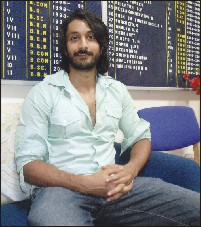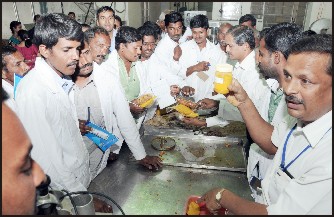
Delivering Quality Food Products to Mysoreans
By S. Kenneth Shishir
India is known as the “Home of Spices” and has a long history of trading. It is a known fact that even the Britishers who came to India as traders, were drawn towards the rich fragrance of these spices. Today, Indian spices are popular all over the world, for their exquisite aroma, texture and taste. In fact, India has the largest domestic and global market for spices.
One such industry in Mysore which manufactures spice powders and Vermicelli is Ganesha Food Products located at Belagola Food, Industrial Area, Metagalli, in city, which has become a household name, especially for its Vermicelli.
Started by Krishnamurthy at a small corner of his home in 1976 by manufacturing vermicelli and various spice powders, Ganesha Food Products, now, supplies chilly powder, turmeric powder, coriander powder and Puliyogare mix to various outlets in Mysore district.
Krishnamurthy, speaking to Star of Mysore, said, “Marketing in those days was really difficult. I was supplying products to K.R. Hospital, P.K. Sanatorium and many hostels in city; it was a one man show then.”
“In 1990, I thought of expanding the unit and by chance saw an advertisement in the paper about a sick unit in city being put up for sale. I immediately approached KSFC which provided me with financial assistance. I then started a manufacturing unit under the name Ganesha Food Products in 1992. The then DGM of KSFC helped me a lot,” he added.
Soon after, Krishnamurthy’s eldest son Narasimhamurthy, after completing his PU, joined the business. Then his other sons Keshavamurthy, a BE (Mech.) graduate, Guruprasad, a B.Com graduate and Raghavendra, a BE (Electricals) graduate, joined too, thus making it a family business.
His business grew and Krishnamurthy then faced the problem of space constraint. He then bought another sick unit and launched a second unit of Ganesha Products, close to the first unit. Even this time, KSFC came to his help and provided financial assistance.
Speaking about the quality of his products, Krishnamurthy said that his products were getting good response from the consumers due to the quality of products that he is maintaining since its inception till date. “Giving our consumers quality food products is our motto and we never compromise on quality,” he added.
He further said, “because we give quality products, we have survived in this industry. Food industries today, are facing a lot of competitions and most of the food industries in the surroundings have closed down due to stiff competitions from MNCs.”
Krishnamurthy said, apart from catering to the needs of our own Mysoreans, we now supply our products to other parts of Mysore district, Bellary, Davangere, Shimoga, Hiriyur, Udupi, Mangalore and other places.
Even major hotels in Mysore and Bangalore use our products.
Speaking about the raw materials required for manufacturing, he said that raw materials are purchased at the source where they are auctioned, example, for an item like Chilly. “We buy the products only after checking it’s quality. Sometimes, products are bought from Maharashtra also if we are not satisfied with the quality of our raw materials at the local markets.”
Speaking about the taxes levied on their products, Krishnamurthy said that the raw materials are exempted from taxes but taxes are levied on the finished products and also for packing materials.
His son Narasimhamurthy said that earlier there were a lot of food industries like pickle manufacturing units, jam manufacturing units, squash manufacturing units and much more in this zone, which is popularly called as ‘Belagola Food Industrial Area,’ but due too stiff competitions from MNCs, most of them have closed down.
He said, “if you want to run an industry you should not depend on anybody. Apart from giving 100% efforts, one has to be a driver, a technician, an electrician and should have a sound knowledge of everything pertaining to the industry to survive and succeed.”
He further said that their products are manufactured according to the standards prescribed by the Food Safety and Standards Authority of India (FSSAI) and to guarantee this standard, they make use of the latest technology and the latest machineries and equipments.
Krishnamurthy said that his industry has survived all these years because of the quality and patience which is a must, also because of good business etiquettes and full support of his family members especially his sons who are now the working partners for the industry.
The work place and all the surrounding places are kept clean, tidy and hygienic in order to have cent percent sanitation. Employees and management of Ganesha Food Products are dedicated in providing best quality foods to every household.
source: http://www.starofmysore.com / Star of Mysore /Home> Feature Articles / February 22nd, 2014















